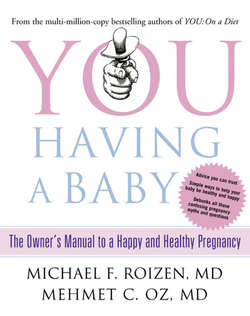Читать книгу You: Having a Baby: The Owner’s Manual to a Happy and Healthy Pregnancy - Michael Roizen F. - Страница 63
What’s Food Got to Do with It?
ОглавлениеYou probably know that diabetes is typically associated with too many calories, so you may be asking yourself how you can become diabetic in pregnancy without overeating. Good question. Normally what happens in an insulin-resistant state is that your appetite increases when glucose can’t get into your cells—especially your liver cells and the satiety center of the brain. In response, you’ll crave and eat simple carbs (chocalert!) to combat those cravings. However, that only increases the glucose surge and starts the whole cycle over again. In gestational diabetes, insulin resistance starts because of the surge of hPL, which increases your blood glucose levels, so it’s not overeating that’s to blame. However, you may still experience cravings for carbs, which exacerbates the situation and, if you’re susceptible, may push you over the line to a full-blown case of gestational diabetes. That’s why we say that even if poor nutrition isn’t the cause per se of gestational diabetes, eating smart will certainly lower your risk of developing it. See our food recommendations throughout the book.
fetus must increase production of its own insulin. This insulin increase acts like a growth hormone. The result is that your baby gains weight too quickly and ends up on the heavy end of the bell-shaped curve.
While it may seem as it’s no big deal for your baby to pack a few extra pounds at birth (“A future offensive lineman!” shouts the uncle), a chunky fetus makes more fat cells in utero. So now the husky baby is not only prone to being overweight as a child, he’s also prone to storing fat as he gets older. (And a baby whose mom had gestational diabetes is also prone to delays in language development.) In addition, immediately after birth, the newborn tends to develop dangerously low blood sugar because his body has been overproducing insulin to cope with his diabetic mother’s sugar, which was leaking into his body. If this occurs, baby has to be monitored closely for the first few days after birth until he can adapt to an environment outside mom’s body.
There are other risks with gestational diabetes as well:Your ob/gyn may want to deliver a bit earlier than your due date if she thinks the baby is getting too big for your britches. And because lung development may not be complete if the baby is delivered early, premature delivery places him at risk for breathing problems after birth.
Gestational diabetes can also pose problems for mom. Without insulin’s ability to move sugar into your cells due to the aforementioned insulin resistance, the extra sugar in your bloodstream acts like shards of glass, scraping up the walls of your arteries and potentially inflaming the blood vessels that go to the placenta. In this case, you can actually end up depriving your baby of oxygen and vital nutrients, and when diabetes predates the pregnancy, it can lead to the opposite extreme of the bell curve with a condition known as intrauterine growth restriction, which we’ll talk about shortly. At the same time, a series of hormones produced by the uterus and mom’s body—namely cortisol (the stress hormone), leptin (the high blood pressure hormone), and adiponectin (an inflammation-reducing hormone)—all flood mom’s bloodstream and contribute to higher glucose levels floating around in a biological never-never land. And all that continues the vicious cycle of too much glucose and insulin resistance.
Considering that up to 10 percent of pregnant women get gestational diabetes, you’re probably wondering who’s at risk. Because of the surge of hPL, all pregnant women are put into this hypermetabolic state of insulin resistance, and most women’s bodies are able to adjust and handle the storm just fine. The problem happens when women have additional risk factors, stemming from either a family history of diabetes or gaining too much weight during pregnancy. (Nearly 30 percent of women who gain forty or more pounds during pregnancy have heavy babies, compared to less than 15 percent of women who don’t gain that much weight.) If you’re already overweight, have had a large baby in the past, have a strong family history of diabetes, or are over twenty-five, you might be more susceptible to responding poorly to hPL and developing gestational diabetes. (See page 90 for how you’re tested.) If you are diagnosed with gestational diabetes, your doc will put you on a special diet, encourage you to exercise, and teach you how to monitor your blood sugar level, which you’ll have to test several times a day.
